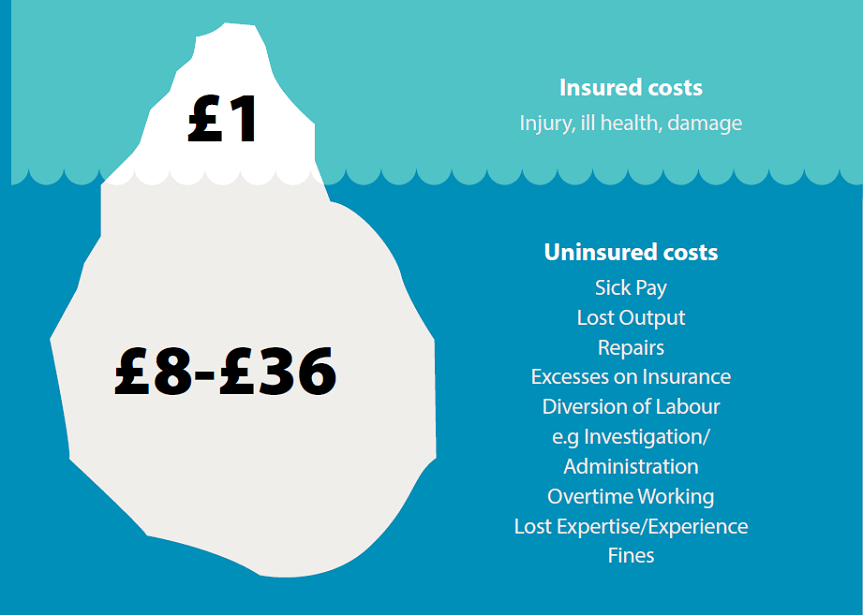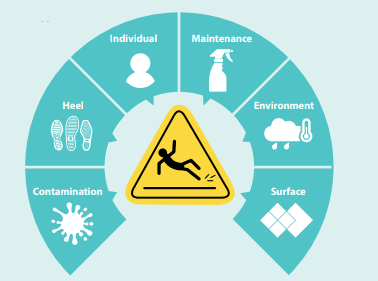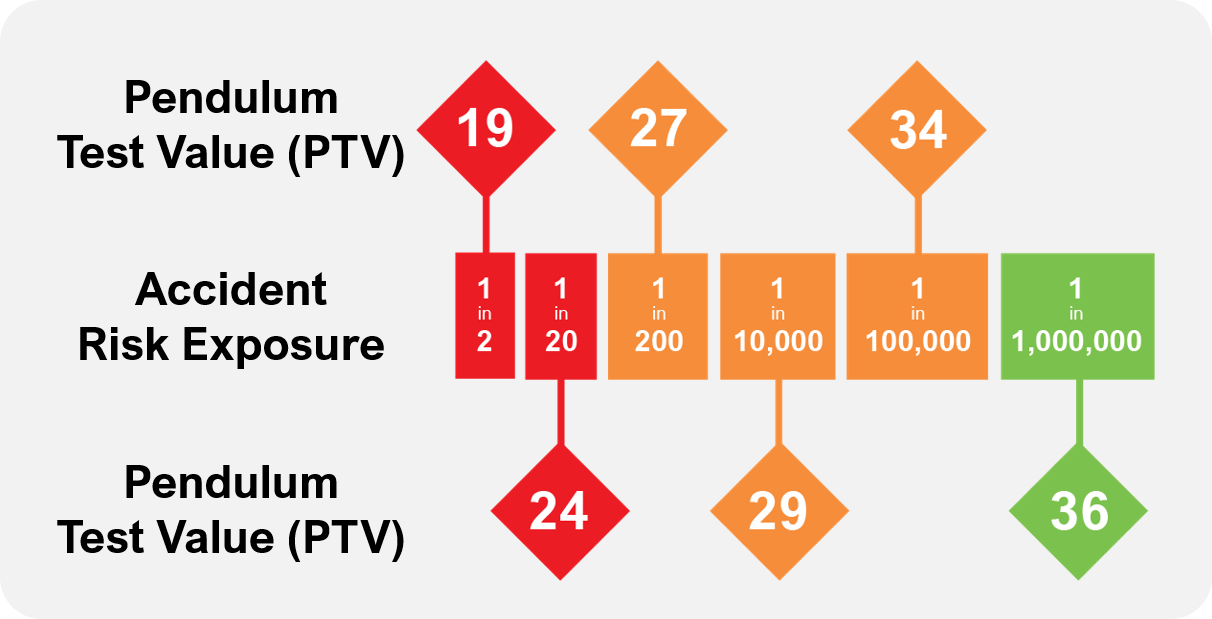Christian Harris of Slip Safety Services takes a view from the floor as he outlines the case for minimising slips and reducing accidents.
Falls are funny.
I see and hear this all the time. Other comments include: “Slips aren’t serious…”, “It’s only £10k…”, “That’s why we’ve got insurance, anyway”.
Nothing boils my blood more than a misunderstanding of the true, holistic cost of risk coupled with an acceptance of harm not only to people’s lives, but to an organisation and to society at large.
My firm belief is that proactive safety and risk management powers business performance. To build anything worthwhile, you need strong foundations. Safety and risk success is the same – build from the ground up by getting to grips with slips.
Death by 1,000 Cuts
While catastrophic risks grab people’s attention, they don’t actually cause the bulk of costs if you look over the long-term. Many people don’t realise what the true cumulative cost of slip accidents is:
- Every year, 300,000+ people go to A&E after a slip
- This results in 1.5m+ NHS bad days – putting severe strain on our health service (indeed, CMO Chris Whitty recently mentioned slips in a Downing Street COVID press briefing)
The average cost of a slip insurance claim is £10,000. To some, £10,000 may not seem like a lot, but when you consider that AXA insurance alone spends £80 million a year on slips, and that they have less than 10% of the UK market, the total annual slip claim bill is £1bn+.
The Accident Costs Iceberg
However, insured costs are only a small proportion of the total financial cost of accidents. The HSE suggests uninsured costs can range from 8X to 36X the insured cost:
A survey we conducted of 150+ H&S leaders agreed on a tighter banding of 10X to 12X. Given £1bn of claims, that’s another £10bn+ of “hidden”, uninsured costs.

Selling Big Macs vs. Stopping Slips?
One strategy I use to sell risk management is to compare the cost of a claim to a unit item with which people can easily identify.
So, how many Big Macs do you need to sell to cover the cost of a £10k slip claim? The answer is almost 20,000!
But that’s only the insured cost…. What about the uninsured costs to cover £135k? The number skyrockets to just over 250,000 Big Macs. That’s a heart attack waiting to happen, whichever way you look at it!
Here’s an exercise for you: What would the number be in your business? Why don’t you calculate this, post it on social media and tag me?
It’s Not All Preventing Bad Thing. Here’s the Positive Side of Risk
Having safer floors, will also mean cleaner floors. Cleaner workplaces are proven to motivate, to drive higher morale and productivity.
A cleaner, safer environment also drives customer experience. In the leisure sector, for example, the average gym in the UK loses £45k of annual turnover through poor cleanliness. But after deep cleans we’ve done, clients have added £250k of membership revenue.
Reputation is Everything
Reputation is the ultimate asset. In 2015, Stanley May, a 74-year-old prominent member of his local community, went shopping in his local Co-Op store in Truro. He slipped on a leaking chiller and passed away as a result.
Yes, there was a civil claim, but there was also a criminal prosecution, a £400k fine and £millions of reputational damage.
Recently, Tesco was fined £733k for a slip under similar circumstances, which thankfully this time only lead to a broken hip. The fine is one thing, but what if people felt going to Tesco was unsafe?
Slips can affect anyone. Even the soon-to-be most powerful man in the world, Joe Biden suffered a slip. In December 2020 he fractured his ankle. Imagine what would have happened had his accident been more serious along the lines of two supermarket cases?
What Ultimate Results can be Achieved?
We’re known for reducing accidents by at least 50% in clients’ buildings. In the last three years we’ve prevented over 3,000 hospital visits and therefore £30m+ of claims.
In one leisure sector example, we helped to reduce claims from one per week to one per month. Whilst this saved them £400k of claims costs and millions of uninsured costs, it also drove up customer satisfaction and sales. And it saved them huge amounts of time, which they decided to reinvest in their chosen charity.
So, in this case, slip safely not only saved the lives and livelihoods of their members but also people around the world.
Tune Your CHIMES to Stop Slips
Other than the misconceptions mentioned earlier, the biggest issue I see with slip safety is that people try to deal with it too superficially. For example, sticking out a yellow sign is no way to prevent an accident, and certainly not any way to defend a claim.

We’ve developed a framework called CHIMES, which is the best practice methodology to review your slip safety risks. Tune all six CHIMES and you’ll see many fewer accidents, less harm and lower costs:
What Gets Measured Gets Managed: It Starts with a Slip Test
You’ll notice that 50% of CHIMES relate to the floor.
Until you know for sure what slip resistance your floor has, you can only ever be guessing about how to reduce slip safety risks. The pendulum slip test is how HSE measures slip risk.
This mimics a slip and gives you a risk category (high, moderate or low slip risk) in dry and wet conditions. Further, it correlates accident risk exposure: A Pendulum Test Value (PTV) of 24 gives 1 in 20 risk; PTV 36 gives 1 in 1,000,000 risk.

Here’s Why – With a Hidden Secret – You Can Save £100,000s With No Initial Outlay
Many people don’t know this, but insurance companies are often willing to fund slip testing (and indeed other risk reduction work) through risk management bursaries.
I recommend you listen to my Safety & Risk Success Podcast interview with Chris Gill where we set out how this works and how to unlock this funding.
Directionally Correct – 20% of Floors Safer Will Reduce Your Risk by 80%
“We can’t keep our floors dry.” “We have so many buildings and so many floors; we’re never going to be able to get on top of this properly.” Sound familiar?
As with many things in life, the 80/20 rule applies here.
Be directionally correct. If you’ve got 20 buildings but you don’t make a start improving them, then they’ll continue to be a problem. Whereas if you start with the worst one worst and carry on from there, at least you’re moving towards the end goal.
In the Brunswick Shopping Centre in Scarborough, with 10,000s of metres of shiny terrazzo floor, it simply wasn’t feasible to make every square foot safe-when-wet. So, we took a targeted approach. The entrance areas were anti-slip treated to make them safe, but still shiny. This was both cost effective and safety effective: our client saw the elimination of accidents over the next 12 months.
To Sum It Up
You can stop slips and this comes with various hidden benefits, which, when, considered alongside the hidden costs of accidents, make slip safety a compelling risk management investment proposition. If you can get funding from your insurer for the initial diagnostic phase, all the better!
Let’s stop slips together!



